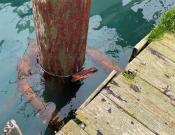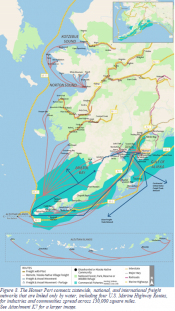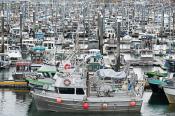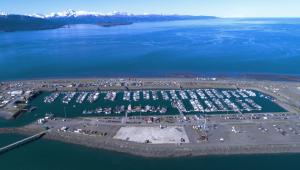-
About Homer
-
- Americans with Disabilities Act Compliance Program City Campgrounds Community Recreation Hickerson Memorial Cemetery
- Library Parks & Trails Public Safety Fire Police Emergency Information
- Events & Activities City Calendar Library Calendar Recreation Calendar Doing Business in Homer Sister City Program Coast Guard City
-
- Departments
- Government
- How Do I?
Homer Harbor Critical Float System Replacement Project
This project completes design, engineering and permitting and replaces two Float Systems in Homer Harbor: Float System 1 and 4. These float systems and adjoining gangways were constructed by the State of Alaska in 1964 as part of the original harbor and transferred to City ownership in 1999 with extensive deferred maintenance. Despite having completed major upgrades to harbor assets in the past ten years and increased maintenance expenditures, the City has been unable to keep pace with infrastructure deterioration.
The scope of the System 4 and 1 replacement project will:
- Bring floats and gangways up to current safety standards.
- Lengthen head float AAA to increase capacity.
- Replace corroded and undersized pilings.
- Replace four 73-foot gangways with safer and climate-resilient covered 100-foot gangways.
- Electrify floats
- Meet ADA accessibility, water, and electrical service code compliance.

Major maintenance (added flotation to the main and stall floats and replacing timber piles and decking) has allowed continued use of these floats. But at over double their engineered life expectancy, the systems exhibit critical loss of structural capacity. A Harbor Condition Survey in 2022 confirmed that the Systems are in critical condition, non-compliant with design, fire protection and safety standards and will soon face load restrictions or decommissioning.

Homer's Port and Harbor is a major regional freight transportation and commercial activity center, providing moorage, maintenance and repair, and cargo loading for vessels serving 130 remote communities in Southcentral and Western Alaska.
In total, the main float systems accommodate 920 stalls for reserved vessels and 4,100 linear feet of transient moorage for vessels up to 75 feet long, with a stall waiting list of over 400 vessels. The harbor also offers a five-lane boat launch ramp, a barge loading area/ramp, vessel repair areas, two fuel floats and a commercial fish dock with an ice plant and cranes to transfer commercial fish and other cargo.
It is a port of refuge for vessels transiting the Gulf of Alaska and Kennedy Entrance, and a critical link in the marine transportation network on which vital industries, the Port of Alaska, and 135 non-road connected villages and work sites in southcentral and western Alaska depend.
- Ninety-two vessels provide freight shipping. For example:
- one water taxi operating out of System 1 delivers on average 125 tons of freight to Kachemak Bay communities monthly during the summer and 80 tons each month the rest of the year;
- a local building materials supplier sends an estimated 1M pounds of construction materials to non-road connected communities in Central and Western Alaska each year.
- Homer provides a critical service for cargo vessels traveling north into the Port of Alaska (POA), which handles 50% of all freight shipped to Alaska and serves 90% of Alaska’s population, as well as tankers delivering fuel to Ted Stevens International Airport. These ships are required to utilize licensed, Cook Inlet-experienced pilots to navigate into the POA. Anchorage-bound ships rely on pilot boats and crews stationed in Homer to complete the trip to the POA. Two vessels provide 480 piloted cargo and tanker trips into the Don Young Port of Alaska annually.
- Commercial fishing vessels home porting, repairing, provisioning, and delivering in Homer participate in Bering Sea crab, Pacific halibut, Bristol Bay salmon, and other fisheries of national and international significance. Homer ranked as the 78th fishing port in the U.S. by weight and 65th by value, with landings of 4.7M pounds of seafood worth $12.5M in 2020.
- Deliveries from the Homer Port also support Bristol Bay economic activity. In 2022, 4M tons of cargo, 300,000 gallons of fuel, and 350 vessel transports via 25 landing craft originated in Homer Port for delivery to Bristol Bay via Williamsport and Iliamna Portage Road, which significantly reduces the journey between Cook Inlet and the Bristol Bay fishing grounds and between Homer and rural Western Alaska and Aleutian Chain villages.

Decommissioning will displace vessels and create hardship for regional transportation networks that depend on safe and efficient operations at Homer Harbor, including the Seldovia Fast Ferry Kachemak Explorer for passenger and freight loading, remote communities in southcentral and western Alaska and the commercial fishing fleet.

The Harbor is operating at or above capacity. Demand for moorage and regional freight movement has increased such that the harbor already cannot meet load bearing and system demands. The loss of floats in Systems 1 and 4 will have a ripple effect, slow the entire Port operations, and contribute to delayed shipments. System-wide closure would affect 336 vessels for System 1 and 167 vessels for System 4, over half the stall capacity in the harbor. Closing even one finger on a float, either for additional repairs or permanently, means that affected vessels have to raft, hot-berth, move to transient moorage, or most likely be displaced entirely from the facility.
Decommissioning an entire float system increases vessel congestion and operational delays related to rafting and tidal draft constraints, cost the harbor and vessel operators time and fuel, and cause life and safety concerns. A sudden float system failure that causes vessel damage would likely cost a fisherman an entire season, incapacitate numerous vessels, slow and disrupt freight delivery schedules, or block access to critical floats and services.
The Port and Harbor Enterprise has established a match reserve and is setting aside funds to support grant matching for design, permitting and construction and will also need to bond for construction, a large undertaking. Floats rated as serious to critical in Systems 4 and 1 moor 503 of the harbor’s 920 vessels and offer 7,524 linear feet of transient moorage.
The City has will be submitting a Federal 2025 Port Infrastructure Development Program grant application for assistance with construction.
An FY25 Community Project Funding request to Congresswoman Mary Peltola was one of fifteen projects the Congresswoman selected to advance to Committee, though as of March 2025 the FY25 Federal Budget has not yet been adopted; an appropriation for the project is not likely.
The City won and is in the process of obligating a $1.1M Denali Commission Transportation Program grant to assist with pre-development design, field investigations, environmental review and permitting activities.



